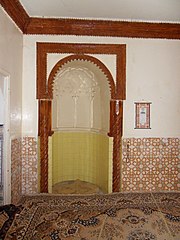| Mellala Mosque | |
|---|---|
| مسجد ملالة | |
 The minaret alongside the courtyard of the mosque The minaret alongside the courtyard of the mosque | |
| Status | active |
| Location | |
| Location | Béjaia, Algeria |
| Geographic coordinates | 36°42′49″N 5°01′14″E / 36.71354°N 5.02055°E / 36.71354; 5.02055 |
| Architecture | |
| Type | Mosque |
| Style | Hammadid, Moorish |
| Founder | Ibn Tumart |
| Date established | circa 1120 CE |
Mellala Mosque(Arabic: مسجد ملالة, romanized: Masjid Malala) also referred to as Ibn Tomart Mosque (Arabic: مسجد ابن تومرت, romanized: Masjid Ibn Tumert) is a historical Mosque located in Béjaia, Algeria. Its construction dates back to the 12th century, during the rule of the Hammadid Emirate.
Background
The Mosque dates back to the era of the Hammadid state, around the year 1120 CE, when Abd al-Mu'min, coming from Nedroma to Béjaïa in search of knowledge, met Ibn Tumart. He had taken refuge in the village of Malala and preached to the people in this mosque. The two men formed an alliance and agreed to launch the Almohad call, which led to the emergence of the Almohad Empire. Mohammed al-Baydhaq mentioned in his account regarding the Malala Mosque:
The sons of Al-Aziz, when they saw Ibn Tomart in Malala, said to him: O jurist, we want to build a mosque for you here.' He said to them, may Allah be pleased with him: 'If you wish, then build a mosque for him here,' and students began to come to it from everywhere to pray.
Architecture

All that remains of the old Hammadid mosque are traces of its mihrab in the form of a semicircular arch, with its decorations believed to be modern. However, the motifs situated above it are original, taking the form of interlocking ornamentation reminiscent of those found in Almohad architectural structures, particularly seen in the minarets of Hassan Mosque in Rabat, Kutubiyya Mosque in Marrakech, and Giralda in Seville. The construction of the mihrab is visibly raised from the wall's surface and made of regular bricks. Interestingly, the mosque is not oriented towards the qibla but rather towards the south, outside the qibla wall. In front of the mihrab lies a tomb, believed to be that of Sidi Yahya Abi Zakaria, although sources like Ouratilani and Alghobrini suggest he was buried in Béjaïa, hence locals refer to him as Sidi Yahya Abi Qubrayn.
The old mosque was demolished and replaced by a new one, nearly identical in size to the original, known as Ibn Tumart Mosque, constructed in the 1960s. It is considered one of the oldest mosques in Béjaïa, alongside the Casbah Mosque and the Abu Zakariyya Mosque.
Ibn Tumart

Upon the construction of the Mosque. Many students were attracted from all over. After the lesson in his mosque, Ibn Tumart would sit at the crossroads under the carob tree, engaging in remembrance of Allah. One day, upon entering Béjaïa and reaching Bab Al-Bahr, he poured wine on the ground, which was being sold there. Ubayd Sab, the son of emir Al-Aziz beat him, after this incident Ibn Tumart returned to his mosque at mellala. Al-Baydhaq later spoke about the meeting between Ibn Tumart and Abd al-Mu'min. Most other sources confirm that the meeting took place in Malala. Ibn Tumart then traveled to the far west accompanied by Abd al-Mu'min. According to Ibn Al-Qattan's account, Ibn Tumart encountered in Béjaïa some young men dressed as women, impressing those corrupt in morals, so he put an end to this reprehensible behavior. On one occasion, men were seen mingling with women and children, dressed in the finest clothes, with adorned eyes. He lashed out at them, leading to quarrels and women being stripped of their jewelry. When the Hammadid Emir Al-Aziz learned of this, he ordered some Ulamas to converse with the jurist "Al-Sous" (a nickname given to Ibn Tumart), who was involved in the incident. They gathered at one of their houses, brought food and drinks, and did invite one of their colleagues to bring the imam from the Mellala mosque that he frequented. He refused their invitation. They then sent the scribe Omar bin Filful, who succeeded in persuading him with kindness and attempted to convince him to stop from denouncing the sins. The debate ended with the Imam prevailing over his opponents in the city.
There are other noteworthy testimonies, Al Marakushi confirmed that the people of Béjaïa accepted Ibn Tumart's observations, but the Hammadid Emir expelled him. Al-Zarqashi narrated that Ibn Tumart moved to Béjaïa, where the governor was Al-Aziz ibn Al-Mansur ibn Al-Nasir ibn Alnas ibn Hamad Al-Sanhaji and sat on a rock by the roadside near the lands of Malala, which is still known to this day (meaning during the lifetime of the author).
References
- ^ عبد الواحد المراكشي (1949). المعجب في تلخيص أخبار المغرب. Cairo: مطبعة الاستقامة. p. 202.
- Rachid Bourouiba. The Hammadid State: Its History and Civilization (in Arabic). p. 210.
- ^ Mohammed al-Baydhaq. A complete edition of the news of Al-Mahdi Ibn Tumart and the beginning of the Almohad state. p. 13.
- ^ Hady Roger idris. The book "Al-Dawla Al-Sanhajiyya: A History of Ifriqiya during the Era of the Zirid Dynasty – From the 10th to the 12th Century CE. p. 386.
- ^ AZZOUG_ABDELKRIM. The Islamic archaeological landmarks of Béjaïa and its surroundings (in Arabic). p. 43.
- Lucien Golvin (1970). Essai sur l'architecture religieuse musulmane Volume 4 (in French). Klincksieck. p. 269. ISBN 978-2-252-01545-2.
- Al-Zarkashi. The History of the Almohad and Hafsid States (in Arabic). p. 12.
| Algiers | |
|---|---|
| Constantine |
|
| Tlemcen | |
| Oran |
|
| Other cities | |